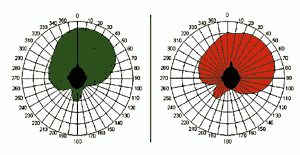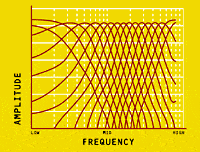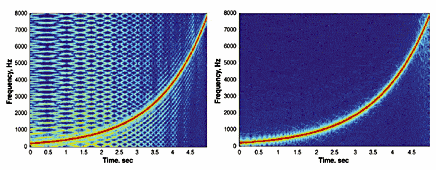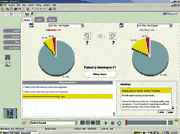Hearing instrument development has historically been a technology-driven process. A different tactic was taken with the development of ReSoundAIR and Canta7 Open hearing instruments: the identification of user needs were first explored, followed by the implementation of appropriate technologies to address those needs. The same was true in designing the new ReSound Metrix, where four key areas for success in fitting and wearing hearing instruments were identified and addressed: speech clarity, sound quality, fitting accuracy, and open-fitting comfort.
The combination of ReSound Metrix features and the new Aventa 2 software work in concert to optimize performance in each of these areas. In addition, the new hearing instrument is designed to function in a perceptually “transparent” manner, allowing the wearer to hear well in all situations without being made aware of the sound processing per se. The following article focuses on these four key areas, and provides highlights of this new technology platform.
Speech Clarity
Enhanced directionality. Ensuring speech clarity involves providing appropriate gain for varying levels of speech and boosting signal-to-noise ratio (SNR) through directional processing.
The Metrix Real-world Adaptive Directionality was developed to improve upon existing directional technologies in several important ways. First, dynamic time constants allow the system not only to track moving noise sources, but also to cancel multiple noise sources with varying frequency content simultaneously. Second, the Real-world Adaptive Directionality system is the first to steer the directional beam completely to the front of the wearer. Other systems, which have excellent directional characteristics in free field, do not provide as good amplification for frontally incident sounds with the device in situ, according to our research (Figure 1). The new directional system also takes into account proximity effects, so that sounds occurring near the instruments—like the wearer’s own voice and wind noise—are not over-amplified.

FIGURE 1. Real-world Adaptive Directionality (left panel) steers the directional beam toward 0° azimuth on the head of the wearer. Other directional systems (right panel) in situ show most directionality off to the side.
Finally, the new directional processing incorporates compensation for the low frequency roll-off associated with directional systems, eliminating the need to add low frequency gain—and noise—via the compressor.
|
Adaptive directionality with gradual directional switching. Selectable directionality requires that the wearer be capable of analyzing his/her acoustic environment, recognizing when directionality would be beneficial, and manually switching to this response. Obviously, not every hearing instrument wearer will possess all these capabilities, and thus may not derive the potential benefit of directionality. The ReSound Metrix resolves this issue by offering SoftSwitching, which automatically switches to a directional response based on an acoustic analysis of the sound environment. Speech and noise detection algorithms determine the nature of the acoustic surroundings based on the frequency content and spectral balance, as well as the temporal properties of the incoming sound. If conditions are such that the wearer is likely to benefit from directionality, the Real-world Adaptive Directionality is gradually activated. This occurs over a span of approximately 20 seconds to make the transition unobtrusive for the wearer.
Feedback cancellation in both microphones. Audibility is also a key issue for speech clarity, and acoustic feedback is an interfering factor for many hearing instrument wearers. GN ReSound’s Digital Feedback Suppression (DFS) technology eliminates feedback by estimating the path of the sound escaping from the ear canal back to the hearing aid microphone and adding a signal opposite in phase to cancel it. The Dual Stabilizer DFS is a fifth-generation feedback cancellation system, and is believed to be the only one designed to work concurrently with advanced adaptive directional processing. Because advanced directional systems adapt to multiple-frequency noise sources, they alter phase characteristics of the input in ways that cannot be modeled accurately with a 1-channel feedback cancellation system.
One-channel feedback cancellation may result in feedback and ringing artifacts when the wearer of such a device listened in the directional mode. The Dual Stabilizer DFS has a separate feedback cancellation channel for each microphone, which allows accurate modeling of the feedback path to each microphone and ensures adequate headroom and good sound quality in both the omnidirectional and directional modes.
Sound Quality
Superior sound quality is what makes the difference between a hearing instrument which simply amplifies sound and one that is a pleasure to wear. To audiophiles, good sound quality means a true reproduction of the input sound. For the hearing instrument wearer, sound quality is less easily defined, because hearing instrument processing strategies significantly change the incoming sounds as they aim to compensate for lost auditory function. For hearing instrument wearers, sound quality means that sounds are within their range of hearing (and not dropping below threshold or exceeding UCL), that sounds are not distorted, that they are not overwhelmed by amplification of unwanted sounds, and that noise or sound artifacts of the processing are not added.

Seventeen-band compression and noise reduction with frequency warping. The Metrix Warp compression system and NoiseTracker noise reduction are designed to deliver excellent sound quality. The 17-band Warp compressor (Figure 2) utilizes frequency warping, a method by which the uniform frequency processing inherent to digital techniques is mapped to the non-uniform frequency resolution of the human auditory system. The Warp compressor is designed not only to provide an excellent representation of auditory system frequency and temporal resolution, it is also highly efficient and results in virtually no distortion (Figure 3).

FIGURE 3. Spectrogram showing the responses for a swept tone for an FFT-based compressor (left panel) and the Warp compressor (right panel). Nonlinear distortion is indicated by a lattice pattern in the measurement. The Warp compressor shows virtually no nonlinear distortion.
Noise reduction via spectral subtraction. Noise reduction strategies are also an important contributor to sound quality, as they can diminish amplification of some unwanted sounds, thereby alleviating the fatigue and annoyance many hearing instrument wearers experience. Noise reduction in digital devices has worked by reducing gain in frequency bands where level fluctuations of the incoming sound are small, indicating a low probability for the presence of speech. Generally, these schemes work well when in the presence of steady-state noises, like a fan or motor, but not when the competing noise consists of many people talking.
NoiseTracker noise reduction is the first to use spectral subtraction rather than gain reduction. With spectral subtraction, the noise is estimated and its spectrum subtracted from the input instead of just reducing gain in the bands with low modulation. Extremely fast processing in the time domain is essential for the success of a spectral subtraction strategy, because the speech and noise make-up in most real-world listening environments is ever-changing. Having met this criterion, the advantage of NoiseTracker is that it is effective in reducing both steady-state noise as well as background speech babble while preserving the dominant speech signal.
Fitting Accuracy
When a client comes in for a fitting follow-up, they are expected to remember and report on how, when, where, and how much they used their hearing instruments in addition to how well they have been hearing. They may even be asked to describe their listening environments. These tasks are difficult for many clients and impossible for others, leaving the professional to make educated guesses regarding use of the hearing instruments, listening needs and appropriate adjustments and counseling.

Datalogging and analysis of hearing instrument use. One way Metrix assists in improving fitting accuracy is by use of datalogging and analysis. The hearing aid automatically logs information regarding usage and listening environments, and the Onboard Analyzer in the Aventa 2.0 software assists the professional in interpreting and using this wealth of information. Not only does it provide beneficial information to supplement client report, it allows the professional to base fine-tuning and counseling on objective data and actual behavior, and affords an objective way of documenting listening needs (Figure 4).
Open Comfort
A renewed focus on improving wearing comfort via open hearing instrument fittings has been spurred by technologies such as Stabilizer DFS, which restores the gain sacrificed by the open fitting. The ReSound Metrix is well-suited to fitting nearly any hearing loss with any venting strategy. Dual Stabilizer DFS ensures that the needed gain will be available, while the efficiency of the ReSound Metrix signal processing and its powerful computer chip keep the time it takes from sound entering the hearing instrument microphone until it exits the receiver well within the limits crucial for open fittings.
The new product line incorporates many innovative earmold and shell solutions for cosmetically pleasing open fittings.
Summary
Through a combination of technologies, the ReSound Metrix has been developed to solve key challenges in the areas of speech intelligibility, sound quality, fitting accuracy, and open-fitting comfort. Each technology has been designed to work “transparently,” so that hearing care professionals can help their clients to better hearing without requiring them to be constantly aware of the listening solution.
| This article was submitted to HR by Jennifer Groth, MA, the senior research audiologist at GN ReSound Group North America, Chicago, Ill. Correspondence can be addressed to HR or Jennifer Groth, GN ReSound Group North America, 4201 W Victoria, Chicago, IL 60646; email: [email protected]. |





